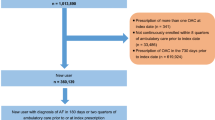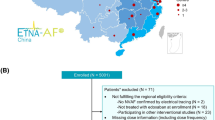Abstract
Aims
This study attempts to identify predictors associated with bleeding and stroke and systemic embolism (SSE) in Singaporean Asians taking rivaroxaban and apixaban.
Methods
A total of 134 Singaporean patients on either rivaroxaban or apixaban for non-valvular atrial fibrillation were included for this study. Baseline characteristics were recorded at recruitment while bleeding and SSE events were recorded during a 1-year follow-up. Peak and trough drug plasma concentrations were collected based on the dosing interval and pharmacokinetics of the drugs and quantified using high performance liquid chromatography. Characteristics of patients with or without bleeds were compared using relevant statistical tests. Multivariable regression that included covariates with p < 0.1 from an initial univariable regression was performed to analyse predictors that resulted in higher risk of bleeding in patients.
Results
Median creatinine clearance (CrCl) was significantly lower in patients on rivaroxaban who experienced bleeds as compared to patients who did not experience bleeds (61.5 vs 70.8 mL/min, p = 0.047), while concomitant simvastatin use was found to be independently associated with a sixfold increased risk of bleeding (adjusted OR = 6.14 (95% CI: 1.18–31.97), p = 0.031) for rivaroxaban after controlling for body mass index, CrCl and having experienced a previous SSE.
Conclusion
Our findings suggest that concomitant use of simvastatin with rivaroxaban may be associated with bleeding events in an Asian cohort. Further studies using physiologically based pharmacokinetic modelling are required to investigate the drug-drug interactions between these drugs.

Similar content being viewed by others
Data Availability
The datasets generated during and/or analysed during the current study are not publicly available due to privacy or ethical restrictions but are available from the corresponding author on reasonable request.
References
Amerena J, Ridley D. An update on anticoagulation in atrial fibrillation. Heart Lung Circ. 2017;26(9):911–7.
Go AS, Hylek EM, Phillips KA, et al. Prevalence of diagnosed atrial fibrillation in adults: national implications for rhythm management and stroke prevention: the AnTicoagulation and Risk Factors in Atrial Fibrillation (ATRIA) Study. JAMA. 2001;285(18):2370–5.
Eagle KA, Cannom DS, Garcia DA. Management of atrial fibrillation: translating clinical trial data into clinical practice. Am J Med. 2011;124(1):4–14.
Ueberham L, Dagres N, Potpara TS, et al. Pharmacological and non-pharmacological treatments for stroke prevention in patients with atrial fibrillation. Adv Ther. 2017;34(10):2274–94.
January Craig T, Wann LS, Alpert Joseph S, et al. 2014 AHA/ACC/HRS Guideline for the management of patients with atrial fibrillation. J Am Coll Cardiol. 2014;64(21):e1–76.
January CT, Wann LS, Calkins H, et al. 2019 AHA/ACC/HRS focused update of the 2014 AHA/ACC/HRS Guideline for the management of patients with atrial fibrillation: a report of the American College of Cardiology/American Heart Association Task Force on Clinical Practice Guidelines and the Heart Rhythm Society in Collaboration With the Society of Thoracic Surgeons. Circulation. 2019;140(2):e125–51.
Hindricks G, Potpara T, Dagres N, et al. 2020 ESC Guidelines for the diagnosis and management of atrial fibrillation developed in collaboration with the European Association for Cardio-Thoracic Surgery (EACTS): the Task Force for the diagnosis and management of atrial fibrillation of the European Society of Cardiology (ESC) Developed with the special contribution of the European Heart Rhythm Association (EHRA) of the ESC. Eur Heart J. 2021;42(5):373–498.
Steffel J, Verhamme P, Potpara TS, et al. The 2018 European Heart Rhythm Association Practical Guide on the use of non-vitamin K antagonist oral anticoagulants in patients with atrial fibrillation. Eur Heart J. 2018;39(16):1330–93.
Mismetti P, Laporte S. New oral antithrombotics: a need for laboratory monitoring. For J Thromb Haemost. 2010;8(4):621–6.
Patel MR, Mahaffey KW, Garg J, et al. Rivaroxaban versus warfarin in nonvalvular atrial fibrillation. N Engl J Med. 2011;365(10):883–91.
Granger CB, Alexander JH, McMurray JJ, et al. Apixaban versus warfarin in patients with atrial fibrillation. N Engl J Med. 2011;365(11):981–92.
Testa S, Legnani C, Antonucci E, et al. Drug levels and bleeding complications in atrial fibrillation patients treated with direct oral anticoagulants. J Thromb Haemost. 2019;17(7):1064–72.
Testa S, Paoletti O, Legnani C, et al. Low drug levels and thrombotic complications in high-risk atrial fibrillation patients treated with direct oral anticoagulants. J Thromb Haemost. 2018;16(5):842–8.
Testa S, Tripodi A, Legnani C, et al. Plasma levels of direct oral anticoagulants in real life patients with atrial fibrillation: results observed in four anticoagulation clinics. Thromb Res. 2016;137:178–83.
Weber J, Olyaei A, Shatzel J. The efficacy and safety of direct oral anticoagulants in patients with chronic renal insufficiency: a review of the literature. Eur J Haematol. 2019;102(4):312–8.
Hirsh Raccah B, Rottenstreich A, Zacks N, et al. Drug interaction as a predictor of direct oral anticoagulant drug levels in atrial fibrillation patients. J Thromb Thrombolysis. 2018;46(4):521–7.
Ng THO, Goh JJN, Aw JWX, et al. Comparison of rivaroxaban concentrations between Asians and Caucasians and their correlation with PT/INR. J Thromb Thrombolysis. 2018;46(4):541–8.
Lin SY, Kuo CH, Yeh SJ, et al. Real-world rivaroxaban and apixaban levels in Asian patients with atrial fibrillation. Clin Pharmacol Ther. 2020;107(1):278–86.
Shahbaz H, Gupta M. Creatinine Clearance. Treasure Island (FL): StatPearls Publishing; 2021.
Schulman S, Kearon C. Definition of major bleeding in clinical investigations of antihemostatic medicinal products in non-surgical patients. J Thromb Haemost. 2005;3(4):692–4.
Mueck W, Stampfuss J, Kubitza D, et al. Clinical pharmacokinetic and pharmacodynamic profile of rivaroxaban. Clin Pharmacokinet. 2014;53(1):1–16.
Mueck W, Kubitza D, Becka M. Co-administration of rivaroxaban with drugs that share its elimination pathways: pharmacokinetic effects in healthy subjects. Br J Clin Pharmacol. 2013;76(3):455–66.
Gnoth MJ, Buetehorn U, Muenster U, et al. In vitro and in vivo P-glycoprotein transport characteristics of rivaroxaban. J Pharmacol Exp Ther. 2011;338(1):372–80.
Cheong EJY, Teo DWX, Chua DXY, et al. Systematic development and verification of a physiologically based pharmacokinetic model of rivaroxaban. Drug Metab Dispos. 2019;47(11):1291.
Tan HL, Tang LWT, Chin SY, et al. Investigation of the arcane inhibition of human organic anion transporter 3 by benzofuran antiarrhythmic agents. Drug Metab Pharmacokinet. 2021;38: 100390.
Yang SH, Choi JS, Choi DH. Effects of HMG-CoA reductase inhibitors on the pharmacokinetics of losartan and its main metabolite EXP-3174 in rats: possible role of CYP3A4 and P-gp inhibition by HMG-CoA reductase inhibitors. Pharmacology. 2011;88(1–2):1–9.
Lee CA, Jones JP 3rd, Katayama J, et al. Identifying a selective substrate and inhibitor pair for the evaluation of CYP2J2 activity. Drug Metab Dispos. 2012;40(5):943–51.
Wang E, Casciano CN, Clement RP, et al. HMG-CoA reductase inhibitors (statins) characterized as direct inhibitors of P-glycoprotein. Pharm Res. 2001;18(6):800–6.
Hochman JH, Pudvah N, Qiu J, et al. Interactions of human P-glycoprotein with simvastatin, simvastatin acid, and atorvastatin. Pharm Res. 2004;21(9):1686–91.
Burckhardt G. Drug transport by organic anion transporters (OATs). Pharmacol Ther. 2012;136(1):106–30.
Windass AS, Lowes S, Wang Y, et al. The contribution of organic anion transporters OAT1 and OAT3 to the renal uptake of rosuvastatin. J Pharmacol Exp Ther. 2007;322(3):1221–7.
Takeda M, Noshiro R, Onozato ML, et al. Evidence for a role of human organic anion transporters in the muscular side effects of HMG-CoA reductase inhibitors. Eur J Pharmacol. 2004;483(2–3):133–8.
Yang Q, Sun D, Pei C, et al. LDL cholesterol levels and in-hospital bleeding in patients on high-intensity antithrombotic therapy: findings from the CCC-ACS project. Eur Heart J. 2021.
Jones PH, Davidson MH, Stein EA, et al. Comparison of the efficacy and safety of rosuvastatin versus atorvastatin, simvastatin, and pravastatin across doses (STELLAR* Trial). Am J Cardiol. 2003;92(2):152–60.
Grgurevich S, Krishnan R, White MM, et al. Role of in vitro cholesterol depletion in mediating human platelet aggregation. J Thromb Haemost. 2003;1(3):576–86.
Del-Carpio Munoz F, Gharacholou SM, Munger TM, et al. Meta-analysis of renal function on the safety and efficacy of novel oral anticoagulants for atrial fibrillation. Am J Cardiol. 2016;117(1):69–75.
Baumgarten M, Gehr T. Chronic kidney disease: detection and evaluation. Am Fam Physician. 2011;84(10):1138–48.
Schachter M. Chemical, pharmacokinetic and pharmacodynamic properties of statins: an update. Fundam Clin Pharmacol. 2005;19(1):117–25.
Kubitza D, Becka M, Zuehlsdorf M, et al. Body weight has limited influence on the safety, tolerability, pharmacokinetics, or pharmacodynamics of rivaroxaban (BAY 59–7939) in healthy subjects. J Clin Pharmacol. 2007;47(2):218–26.
Gulseth MP, Michaud J, Nutescu EA. Rivaroxaban: an oral direct inhibitor of factor Xa. Am J Health Syst Pharm. 2008;65(16):1520–9.
Byon W, Garonzik S, Boyd RA, et al. Apixaban: a clinical pharmacokinetic and pharmacodynamic review. Clin Pharmacokinet. 2019;58(10):1265–79.
Keizer RJ, Jansen RS, Rosing H, et al. Incorporation of concentration data below the limit of quantification in population pharmacokinetic analyses. Pharmacol Res Perspect. 2015;3(2): e00131.
Acknowledgements
The authors wish to extend their thanks to Ms Lin Yingying (Khoo Teck Puat Hospital) for her help with data collection and data preparation for this study.
Author information
Authors and Affiliations
Contributions
Participated in research design: XQ Soh, DSY Tan and ECY Chan. Performed data analysis: XQ Soh. Wrote or contributed to the writing of the manuscript: XQ Soh, DSY Tan and ECY Chan.
Corresponding author
Ethics declarations
Ethics Approval and Consent to Participate
Ethics approval was obtained from the Domain Specific Review Board (Study reference number: 2017/00815). Informed consent by participants was obtained prior to data collection.
Competing Interests
The authors declare no competing interests.
Additional information
Publisher’s Note
Springer Nature remains neutral with regard to jurisdictional claims in published maps and institutional affiliations.
Supplementary Information
Below is the link to the electronic supplementary material.
Rights and permissions
About this article
Cite this article
Soh, X.Q., Tan, D.SY. & Chan, E.C.Y. Simvastatin, but Not Atorvastatin, Is Associated with Higher Peak Rivaroxaban Serum Levels and Bleeding: an Asian Cohort Study from Singapore. Cardiovasc Drugs Ther 37, 917–925 (2023). https://doi.org/10.1007/s10557-022-07346-8
Accepted:
Published:
Issue Date:
DOI: https://doi.org/10.1007/s10557-022-07346-8




